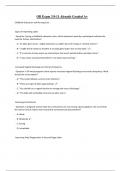Exam (elaborations)
OB Exam 3 8-11 Already Graded A+
- Course
- Institution
OB Exam 3 8-11 Already Graded A+ Childbirth Education and Nursing Care Signs of Impending Labor - Question: During a childbirth education class, which statement made by a participant indicates the need for further clarification? - A: "As labor gets closer, I might experience a sudden burst of...
[Show more]



